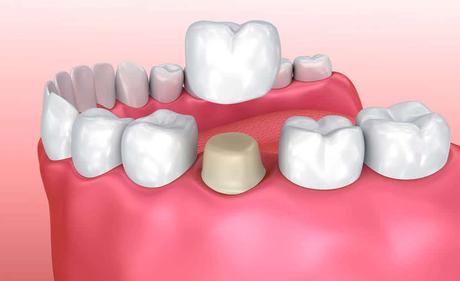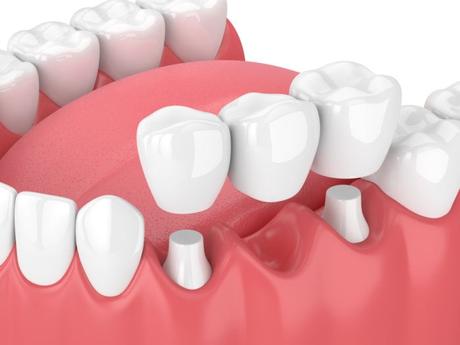No one wants their teeth to be damaged or lost, but these things still happen anyway. As you grow older, tooth loss is inevitable. However, young people can experience it, too.
Fortunately, there are tooth replacement solutions to get your gorgeous smile back in no time no matter your age.
Dental bridges and dental crowns in Fort Lauderdale and around the world are excellent solutions to fix damaged or missing teeth.
These tooth restoration procedures make use of prosthetic devices to restore your natural smile.
Related: Tooth Sensitivity: When to Call the Dentist?
What is Dental Crowns

Your teeth are covered with enamel, a strong protective material that can eventually break down leading to tooth damage. In such cases, a crown may be required. This treatment option will prevent the tooth from further decaying, as well as enhance tooth appearance, strength, and size.
Here are some reasons why you might need a crown:
- Weak, broken, or worn down tooth
- Badly discolored or misshapen tooth
- To cover a dental implant
- To anchor a dental bridge
- Cracked tooth
- The tooth underwent a root canal treatment
- Patient preference for a cosmetic adjustment
- Presence of a large cavity
Types of Crowns
Crowns can be made of stainless steel, all-resin, all-ceramic, porcelain-fused-to-metal, or all metal.
- Stainless steel – These are fabricated crowns used primarily as a temporary treatment for permanent teeth. They protect the filling or tooth while the permanent crown is made from another material. It is the best choice for children because, aside from being cost effective, it doesn’t require multiple dental visits.
- All-resin – These dental crowns are more affordable than all other options. But these wear down easily and are susceptible to fractures.
- All-ceramic – These dental crowns offer a more natural color match and are suitable for people who are allergic to metals.
- Porcelain-fused-to-metal – These dental crowns look most like natural teeth. But the metal under the porcelain layer can be seen as a dark line, especially if your gums recede.
- All-metal – These types of crowns have a high content of platinum or gold or base-metal alloys like nickel chromium and cobalt chromium. Since these can withstand chewing and biting forces, they can last for a long time. Also, they rarely break or chip. However, they are expensive and can cause potential allergic reactions.
What to Expect When You Do the Crown
Unless your dentist has the tools to do the crown in a day, expect to get your crown in at least two appointments.
First appointment
During your initial visit, you will undergo dental X-rays to check the roots of the affected tooth and the surrounding bone. If there is a suspected injury or infection to the pulp of the tooth or the tooth has extensive decay, your dentist will perform a root canal treatment first.
Otherwise, the tooth area will be numbed using anesthesia. Old filling material will then be removed by your dentist. After that, an impression will be taken using a traditional substance or digital equipment. If the crown can’t be made on the same day, your dentist will cover the tooth with a temporary cap.
Second appointment
Your dentist will remove the temporary cap, check your tooth, and cement the crown into place.
Possible discomfort and complications
Getting a crown can involve some complications, such as the ones below:
- The porcelain crown may fall out, become loose, or chipped.
- The nerve inside the tooth may require treatment over time.
- Allergic reactions can happen if the crown is made of metal alloy.
What is Dental Bridges

A dental bridge is a ceramic structure held in place by the abutment teeth on either side of the tooth gap. Here are possible reasons you might need dental bridges in Fort Lauderdale:
- Misaligned teeth
- Being unable to pronounce and speak properly
- Misshapen face
- Bite problems
Types of Dental Bridges
- Traditional – These dental bridges are made up of false teeth kept in place by dental crowns. It is the most popular type used if your natural teeth have gaps because of a missing tooth.
- Maryland – These bridges use two natural abutment teeth like traditional bridges. But while a traditional bridge makes use of dental crowns on abutment teeth, Maryland bridges use a framework of porcelain or metal bonded onto the abutment teeth’s back area.
- Cantilever – These bridges only require the use of one natural tooth next to the gap.
- Implant-supported – As its name implies, these dental bridges use dental implants, not frameworks or crowns. An implant is placed surgically for all missing teeth, and these implants will then hold the bridge in place. This option requires two surgeries – one to embed the implants and a second one to install the bridge. This procedure can take several months to be complete.
What to Expect When You Do the Bridge
Getting dental bridges usually entails two visits.
First Appointment
All preparatory work is done during the initial visit. A drill is used to prepare the teeth that are positioned next to the missing tooth. This means removing some enamel for the crown to fit on the adjacent teeth.
Also, an impression of the teeth is taken, which will then be sent to the dental lab. After that, a temporary bridge is installed to protect the teeth until your next appointment.
Second Appointment
During the second visit, your dentist will cement the custom-made bridge into your mouth to fill the gap. This will then be joined permanently to the abutting teeth.
Dental Crown and Bridge Care
Crowns and bridges can last for a long time, but only with proper care and maintenance. Here are some tips to preserve the longevity of these prosthetic devices:
- Brush twice a day and floss daily.
- Don’t chew on hard or sticky foods like candy and ice.
- Don’t misuse your teeth by chewing on hard objects and your fingernails.
- Schedule regular dental check-ups and cleaning.
Getting a dental crown or bridge can involve certain risks, such as allergic reactions to the materials used and the possibility of infection. However, these risks can be minimized significantly with the right tests and by going to a qualified, professional dentist.
Whichever option you choose, caring for a crown or bridge is crucial. Also, follow your dental visit schedule, so all dental problems can be spotted early on and treated appropriately.

